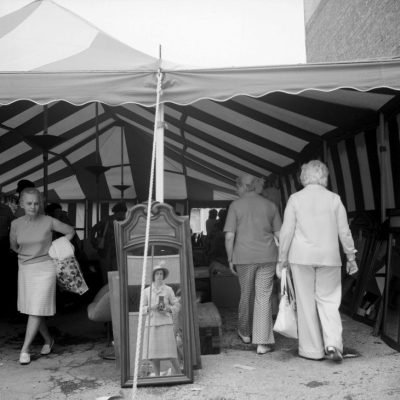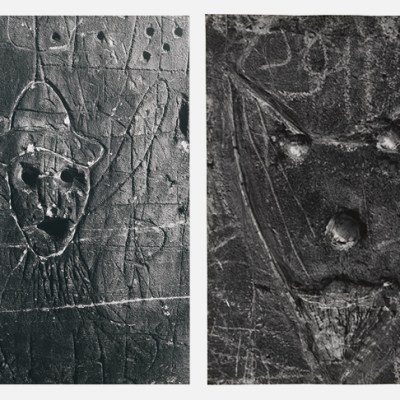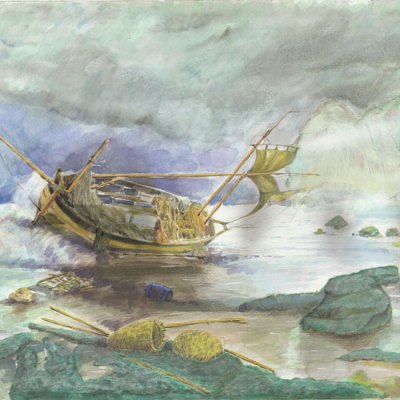From the April 2019 issue of Apollo. Preview and subscribe here.
The light dims as soon as you enter the main display rooms of the Collection de l’Art Brut in Lausanne, a hilly city on Lake Geneva with the Alps never far from view. The museum is located in the converted barn of an 18th-century chateau, which displays some 700 pieces, with 70,000 more stored on site. It is the world’s biggest collection of Art Brut. An iron stairway winds upwards with floor levels chopping up the space. There are small alcoves and back rooms, and the walls of the main rooms are painted jet black, a deliberate contrast, the director Sarah Lombardi tells me, with the white walls of contemporary art museums: ‘After all, Art Brut is an anti-cultural art by definition.’
When the collection opened in 1976 its first director, Michel Thévoz, celebrated the black walls as capturing the ‘aesthetics of anarchy’ in the works on display. It evoked ‘the subconscious, the dream, at least something that disorients us, takes us out of reality’. The collection resisted the conventions and normalisations of the art world because Art Brut was not like any other branch of art. If it was to be exhibited its differences would be retained.
Saint Adolf bitten in the leg by the serpent (1921), Adolf Wölfli. Collection de l’Art Brut, Lausanne. Photo: Marie Humair, Atelier de numérisation – Ville de Lausanne
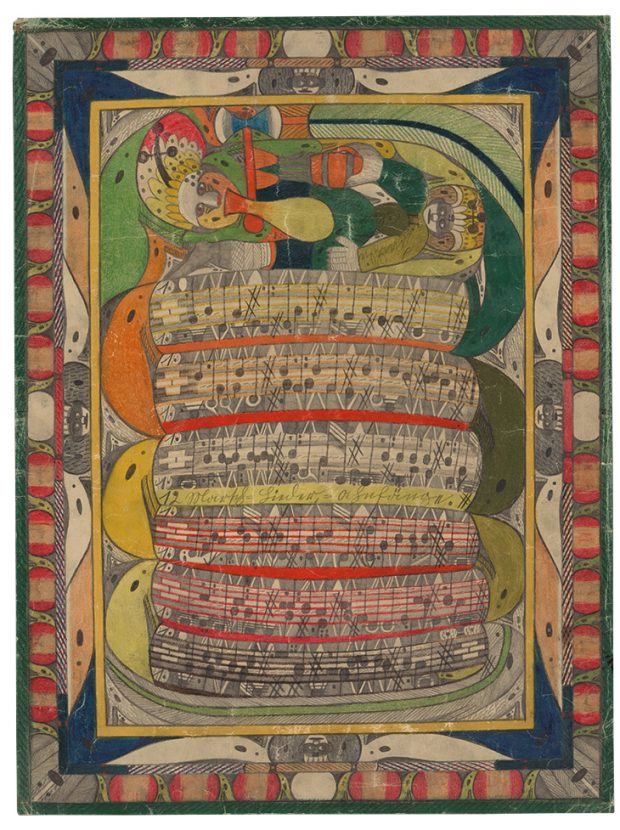
The black walls, which encourage contemplation more than spectacle, have lost none of their power; entering these spaces is like walking into a cave with carvings concealed in the corners. Yet in recent decades a handful of artists – or ‘creators’, as Art Brut experts prefer to call them – have become recognised around the world. A work by Adolf Wölfli (1864–1930), for example, can now sell for more than $100,000. Morton Bartlett and Henry Darger have been exhibited in major museums. The Anglophone term ‘Outsider Art’ has also flourished since it was first coined by Roger Cardinal in 1972 as a loose translation and an expansion of Art Brut.
‘In Outsider Art there is graffiti, popular culture, tattoos, all which are outside official culture,’ Lombardi explains. ‘In Art Brut there is no calculation nor premeditation, it is a completely free art and reflects a singular individuality. That’s why it touches us.’ But despite the raised profile of Art Brut its very existence is part of a still-unresolved argument over its aesthetic qualities and its position within the wider art world.
The French artist Jean Dubuffet (1901–1985) was the collection’s founder and guiding thinker. He derided the ‘mimicry’ he saw among his fellow artists and intellectuals in the West. In Art Brut he championed an alternative model: people working ‘from their own depths and not from clichés of classical art or art that is fashionable’. Wherever you look in Lausanne, Dubuffet is there: his statements are printed on its walls and windows, sometimes reproduced in his own scrawled handwriting. And there are disconcerting echoes of Art Brut in his own work, which evolved from a childlike figuration to bold and colourful, or anguished and monochrome abstractions and sculptures. In the 1940s he began travelling around Europe and the United States, finding and collecting works that he would designate as Art Brut in 1945. By the 1970s he had amassed around 5,000 pieces and he applied for a public utility statute from the city of Paris, which would have given the collection a special status and allowed him to receive donations, but it was refused. He rejected a few other French proposals, including a chateau in Normandy – he did not want the collection to be consigned to the provinces – and eventually turned to Switzerland, donating his collection to Lausanne in 1972 and then partly funding the renovation in the chateau, which belongs to the city.
Untitled (n.d.), Stanislaw Zagajewski. Collection de l’Art Lausanne. Photo: Claude Bonnard

The story of Art Brut stretches back much further, however, to the 19th-century hospitals and asylums of Dumfries, Waldau, Heidelberg, Vienna and Paris. Philosophers and psychiatrists head the Art Brut family tree, figures such as Walter Morgenthaler, Hans Prinzhorn and Leo Navratil; books such as A Mental Patient as Artist (1921) by Morgenthaler on Wölfli, or Artistry of the Mentally Ill (1922) by Prinzhorn, are its founding texts. The terms they used – art of the insane, the alienated artist – were all precursors to what Dubuffet would later call Art Brut. With that name he sought to look beyond works from mental institutions and draw together art that was instinctive, unaware of itself, and unmotivated by thoughts of recognition or display.
French post-war culture was particularly receptive to this new category. Expressionists and Surrealists such as Paul Klee and André Breton saw parallels with the so-called primitive art from Africa that had delighted them in the 1931 Colonial Exhibition in Paris. Art created by people working in various states of trance, muteness and frenzy seemed another authentic model for automatism and direct expressions of the subconscious.
Dubuffet’s ‘L’Art Brut préféré aux arts culturels’ (1949), a manifesto to accompany one of the first exhibitions of Art Brut that took place in the Galerie Drouin in Paris (where today’s annual Outsider Art fair is held), contains one of his clearest formulations of the category:
Here we are witnessing an artistic operation that is completely pure, raw, reinvented in all its phases by its author, based solely on his own impulses. Art therefore, in which is manifested the sole function of invention, and not those, constantly seen in cultural art, of the chameleon and the monkey.
La Tour de New York (between 2001 and 2005), Diego. Collection de l’Art Brut de Lausanne. Photo: Caroline Smyrliadis, Atelier de Numérisation – Ville
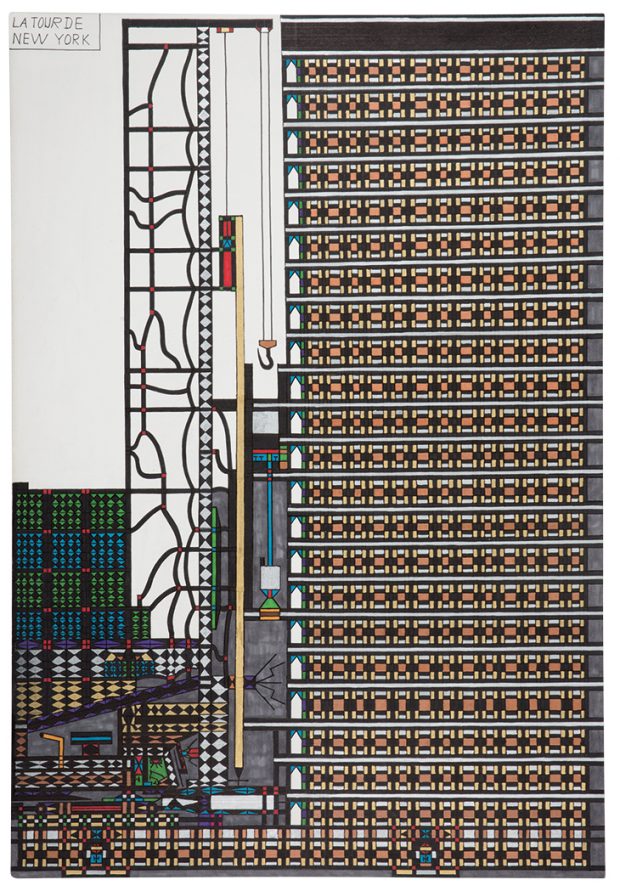
While Dubuffet’s words remain gospel in Lausanne, the collection has also evolved from this position. In its most significant evolution it now displays works labelled Neuve Invention, a sub-category Dubuffet had kept in storage and called the ‘collection annexe’ to include artists who did not fit every Art Brut requirement. This allowed art by children, naïve art and popular art – a pell-mell that points to the narrowness in Dubuffet’s original definition.
As well as the Neuve Invention, the collection has also continued to search for new creators. Its second director Lucienne Peiry sought out artists from all over the world and oversaw the first exhibition of Japanese Art Brut in 2008–09. But beyond this the international hunt has produced slim pickings. ‘Art Brut is a network,’ Pascale Jeanneret, one of the curators, explains. ‘That is how it came into being, that is how it keeps going.’ Many places remain inaccessible. ‘It is true that there are countries where the collective culture is stronger and where individual expression is therefore less present,’ Lombardi tells me, singling out the continent of Africa in particular. ‘The West and the US continue to be continents where there are many Art Brut artists because the culture of individualism remains very strong, and Art Brut depends on this notion.’
As an insight into the word-of-mouth way Art Brut creators are typically discovered, Jeanneret cites the recent case of Diego (b. 1963), a Lausanne-based painter who has two works on display in the white rooms. Diego’s drawings are intricate geometric grids in marker pen on paper, strong colours encased by thick black lines depicting buildings or sections of buildings, set against a spare landscape, either blank or with a few shapes to suggest trees and grass. Diego ‘was the friend of a neighbour of a man who knew a colleague at the collection’, Jeanneret explains. The neighbour managed to take a few photos of what he had spotted behind Diego’s door and when Jeanneret saw them she was stunned. The collection acquired four of his works and now Diego ‘is very proud, his whole family has come and he gets upset when we take the paintings down’.
Something about this story with a happy ending rings false. It touches on the contradiction inherent in the notion of Art Brut: Dubuffet’s ideal of the artist unfettered by external influences, creating without the desire for an audience, only lasts as long as he or she is not picked up by the Art Brut network. When that happens, some form of public exposure will inevitably follow. And, furthermore, if the creator responds to such public recognition, are they no longer makers of Art Brut?
Untitled (between 1936 and 1965), Morton Bartlett. Collection de l’Art Brut, Lausanne. Photos: Caroline Smyrliadis, Atelier de Numérisation – Ville de Lausanne
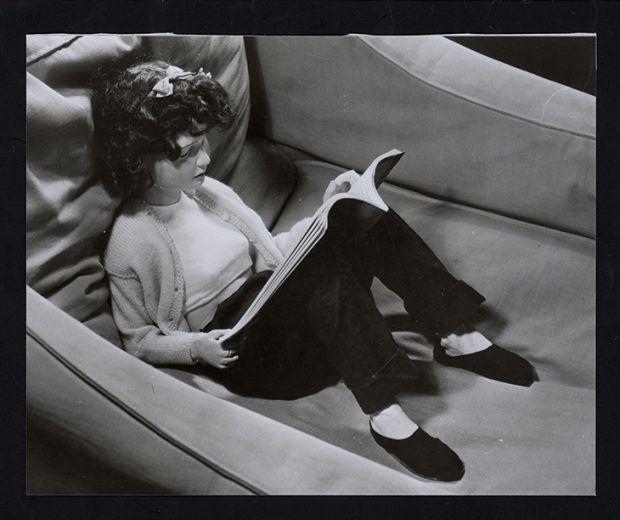
There are cases when public coverage has had negative consequences, forcing an artist to retreat if not cease completely their activity. Morton Bartlett (1909–92) took photos for three decades from the 1930s, developing a series of remarkable photo stagings involving plaster sculptures of dolls with clothes and accessories he also crafted. The dolls are intricate and lifelike; the drama and narrative in the photos beautiful and creepy. Bartlett worked in secret, but an article was published in 1962 after a friend spoke out about his work. Soon after, Bartlett packed up his dolls, detaching all their limbs and wrapping them in newspaper. He never staged another photo shoot again and everything was discovered only after his death.
Lombardi, who has been director since 2012, is steering the collection in a radically changed landscape to that of her predecessors. Private collectors are showing an increasing interest in Art Brut and Outsider Art, raising the prices on the market and making it more difficult for the collection to acquire new works. There are other museums and galleries dedicated to the art too – the Outsider Art Museum in Amsterdam, Prinzhorn’s collection in Heidelberg, the nomadic Museum of Everything and the Halle Saint-Pierre in Paris to name a few, but none on the scale of Lausanne. Lombardi’s response to the growing interest and status is pragmatic. ‘It’s an evolution,’ she tells me, recalling how hostile galleries had been to Art Brut when Dubuffet first introduced the term. ‘I don’t know whether it is positive or not but we cannot oppose it because the market picks up everything, including what seems impossible to pick up, like graffiti on the streets!
Nonetheless the fact that the art market is taking an interest in Art Brut shows that it has an integral place in art and therefore that it has been legitimised, because it is the art market that legitimates works as art.’ As part of her mission she has undertaken to hold thematic Art Brut biennales, the first of which was held in 2013.
Walking through the collection, it seems that many Art Brut artists favour motifs, characters and shapes that they return to constantly, displaying a distinctly obsessive drive. The majority of the works are on paper, for obvious reasons. Beyond this though, there are few of the familiar, thematic and aesthetic resonances that emerge in traditional permanent collections – no family resemblances between different artists, no common dialogue. Each work stands by itself, although there does seem to be a common thread of a drama or trauma sparking the act of creation – illness, an unhappy event, the death of a child, a psychotic episode, an internment, prolonged solitude or alienation.
Hanging in the middle of the opening room is a long banner of connected sheets of paper, flanked by two thin panes of glass. They are covered by the vivid and voluptuous figures of Aloïse Corbaz (1886–1964). The banner has been there since the museum opened. Her flat figures intertwine with shapes in swirling motions, repeated across multiple sheets of paper, all drawn in coloured pencil. The overriding theme of Aloïse’s work was romance. A potted biography (all artists get one, and it is the only curatorial material provided) tells us that she worked in Germany for a time as a governess in the court of Kaiser Wilhelm II and fell in love with him from afar. Returning to her native Switzerland when the First World War broke out, her fantasy continued, intensified, and she was interned for schizophrenia in 1918, at which point she began to draw. At first she worked in secret until doctors encouraged her, and over the years she drew famous figures including Napoleon, Marie-Antoinette and Elizabeth I. There are often couples in her drawings too, partially clothed in pieces of elaborate outfits and jewels, locked together with limbs disjointed.
Untitled (1952), Madge Gill. Collection de l’Art Brut, Lausanne. Photo: Arnaud Conne, Atelier de numérisation – Ville de Lausanne
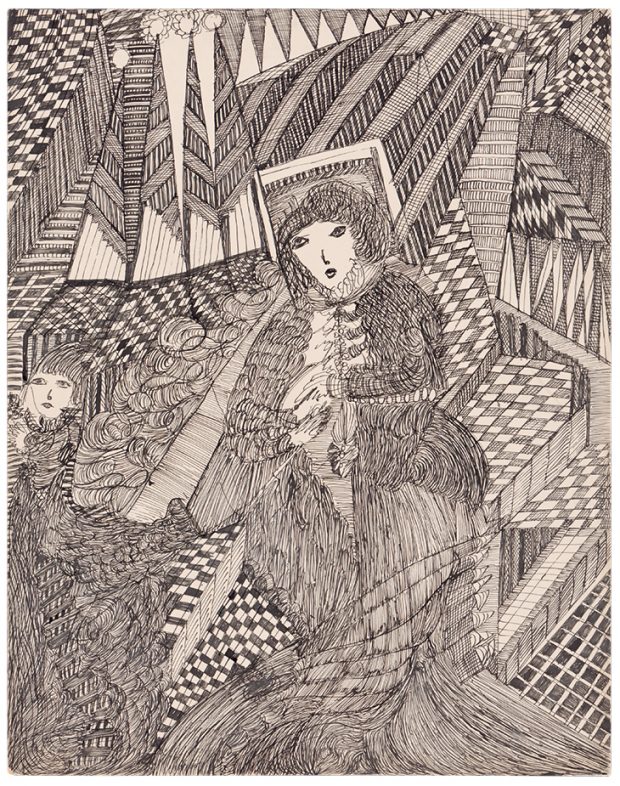
Among the other most arresting works are the vast banners of Madge Gill (1882–1961), an Englishwoman who had an interest in spiritualism and began drawing, writing and embroidering in 1919, a year after her baby died in the Spanish influenza epidemic and she too had been seriously ill and lost the sight in her left eye. A roll of connected sheets of paper several metres long is covered in pen drawings of the same face of an elegant woman in a hat, encased in spirals and grids. Gill drew and embroidered at night, by the light of an oil candle, and said she was guided by ‘Myrninerest’, which has since been speculatively unravelled as ‘My inner rest’.
In contrast to Gill’s large-scale drawings that entirely fill the pages to their edges are the spare pen drawings of Oswald Tschirtner (1920–2007). He was one of a number of patients under the care of the psychiatrist Leo Navratil, who set up a House of Artists at the Gugging Clinic, in a village north of Vienna. As a young man Tschirtner had hoped to become a priest but in the Second World War he enlisted in the navy and became a prisoner of war in the battle of Stalingrad. On return to Austria in 1946 he suffered from post-traumatic stress and was admitted for schizophrenia to the psychiatric hospital in Gugging, where he began to draw. Lausanne holds dozens of Tschirtner’s disorienting and dreamlike drawings, consisting only of black pen lines outlining repetitively the same long figures, either portrait or front-on with similar faces, a pointed nose, a few strands of hair, and bodies dissolving into lines like octopuses floating on the page.
The sculptures by the so-called Prisoner of Basel (1877–1934) are rather more menacing. The handful of his works in Lausanne are displayed in their own special section and, unusually, behind glass – most work here is uncovered, adding to the intimacy of the viewing experience. Joseph Giavarini was an illiterate carpenter who was jailed in the 1920s for murdering his mistress. He suffered from hallucinations at night and began making sculptures that depicted fantastical scenes from workshops, orchestras and circuses. The materials for his statuettes and props included chewed bread that he dipped in hot glue and then painted with thick dabs of colour. The figures of conductors, musicians and acrobats are usually around 15cm high, their thin faces all alike. But there are also two larger, disembodied, almost life-size heads on display. On the crown of one of the pasty, white heads is a bright spattering of red blood.
Untitled (Personnages) (1980), Oswald Tschirtner. Collection de l’Art Brut, Lausanne. Photo: Atelier de numérisation – Ville de Lausanne
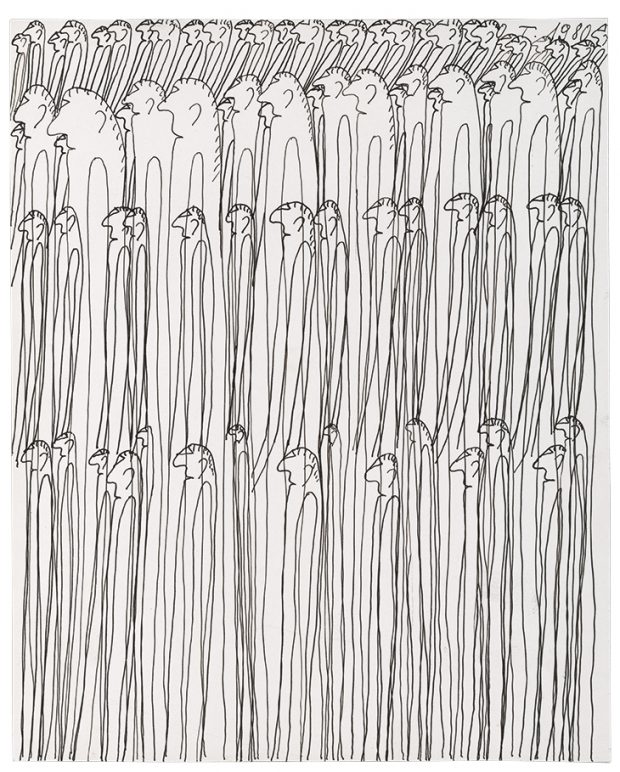
Not everything in the collection convinces as art. The inclusion of some pieces seems tenuous, as though the mental illness of an artist, the act of creating in obscurity or use of unusual materials are enough, and aesthetic considerations only secondary. More troubling is the hint of the fantasy of the noble savage hanging over Art Brut. This has existed since Dubuffet first coined the term and expressed wonder at these ‘raw’ acts of creation that did not apparently think of themselves as art at all. The troubling associations with purity and ignorance persist, with Art Brut now championed as a refreshing alternative to a predictable and money-oriented art world.
This risks preventing the works from being viewed as equal to those of other modern artists. Is it really so preposterous to compare Tschirtner, Gill or Wölfli with the likes of Picasso or Jackson Pollock? If artists are active at the same time, that is sometimes enough to justify seeing them as part of the same world, no matter how different the work. Dubuffet, however, insisted that no work in the Collection de l’Art Brut should be loaned elsewhere. Before the opening of the museum in Lausanne, he had rejected offers from contemporary art museums in Paris to hold his collection on the grounds this would have diluted Art Brut into modern art. At the time he may have felt it necessary to safeguard Art Brut as it sought to establish itself as a willing outlier in the art world. But today, and after seeing so many works of Art Brut exhibited, I would wager Gill, Bartlett, Tschirtner and many others would do just fine hanging in any art gallery around the world.
From the April 2019 issue of Apollo. Preview and subscribe here.
